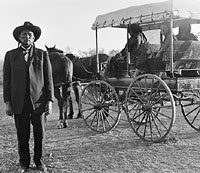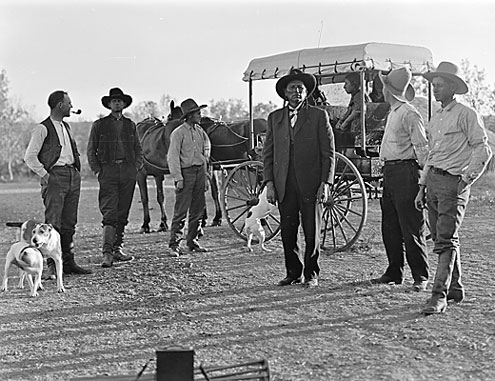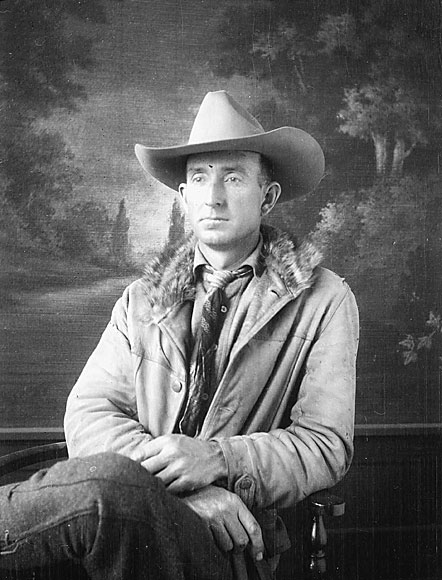The great-grandson of settlers who came to the Republic of Texas in the mid-nineteenth century, Erwin Smith was born in Honey Grove on August 22, 1886. In April 1890, Smith's father, Albert Smith, tragically succumbed to pneumonia. By 1894, Smith's mother, Nancy, married Bonham businessman Percy White and the Smiths moved to Bonham.
In his youth Erwin Smith developed a talent for art, frequently doodling and sketching his favorite subjects, cowboys and Indians. In his late teens into his twenties, he became more serious about his natural ability and attended art schools in Chicago and Boston.
For Smith the idea of spending very much time studying art in fancy schools seemed a waste since the very thing that he wanted to draw or sculpt, the cowboy life on the cattle ranches of West Texas, seemed to be fading quickly. In fact, it seemed to be passing too quickly to be accurately captured on canvass or in stone. A new, faster medium was needed. Fortunately for Smith there was the camera, an artistic tool capable of keeping pace with the disappearing image of the Texas cowboy.
When did Erwin Smith take his first cowboy photograph? Arguably around 1901, according to a story done on him by fellow Bonhamite, Harry Peyton Steger. By January 1906, Smith saw his work appear for the first time in a national magazine entitled, ironically enough, National Magazine. In the years to come there would be many more Erwin Smith photos appearing in many more national magazines and publications thus cementing his reputation as one of the finest photographic chroniclers of West Texas ranch life.
By the time of Erwin Smith's birth in 1886, the Comanche chief Quanah Parker had already spent eleven years confined to an Indian reservation in southern Indian Territory (now Oklahoma). The story of his life had already become legendary in Texas.

Quanah Parker's life lacked the stability and consistency of Erwin Smith's. With white settlers constantly pushing onto lands that the Indians had inhabited for untold generations, conflict and instability for both sides naturally arose, with the Indians getting the worst end of the deal. In the midst of all of this, Quanah Parker found himself constantly on the move and forever planning how he was going to stop white encroachment that was often aided by local law enforcement, state law enforcement (namely the Texas Rangers) and the U.S. military. Thanks to his leadership abilities, he was ultimately made a chief among the Kwahadi Comanches.
The constant fighting between the Indians and their many enemies in Texas finally came to a head in 1874 in what was dubbed the Red River War.
For Parker and his Indian allies the reasons for fighting were many. First, they wanted to retain their freedom. None of them cherished the idea of being confined to a reservation.
Secondly, there was no mistaking the fact that white hunters, with the full blessings and approval of U.S. military leaders, were doing their best to hunt the Indians main meat source, the bison (or buffalo, if you prefer), to extinction.
"Let them kill, skin, and sell until the buffalo is exterminated," stated Army General Phil Sheridan, "as it is the only way to bring lasting peace and allow civilization to advance."
To Parker and his followers this policy was senseless.
As Dee Brown noted in his excellent book Bury My Heart at Wounded Knee: "The free Kwahadis wanted no part of a civilization that advanced by exterminating useful animals."
Thirdly, Quanah Parker and his allies wanted to retain the best lands for themselves. They had always used local lands to take care of local people, and they saw no point in allowing those lands to fall into the hands of cattle ranchers who wanted to use them to create profits for absentee investors living in places like Chicago, New York, Scotland and England.
In 1874 Quanah Parker and his band of Kwahadi Comanches, along with fellow chief Lone Wolf and his band of Kiowas and a band of Cheyennes, had fled the Fort Sill reservation and set up camp in the Palo Duro Canyon. Life for them there was going relatively well. To quote Dee Brown again:
[T]he floor of the canyon along the creek was a forest of tepees - Kiowa, Comanche, and Cheyenne - all well stocked with food to last until spring. Almost two thousand horses shared the rich grass with the buffalo. Without fear, the women went about their tasks and the children played along the streams. For Quanah and the Kwahadis this was the way they had always lived; for Lone Wolf and the Kiowas and the other agency fugitives this was a beginning of life all over again.
By late 1874 the head of the U.S. military, Civil War veteran William Tecumseh Sherman, had had enough. Ultimately five columns of soldiers were sent to Palo Duro Canyon to bring Quanah Parker, Lone Wolf and their followers back to the Fort Sill reservation by force if necessary.
"Thousands of bluecoats," writes Dee Brown, "armed with repeating rifles and artillery were in search of a few hundred Indians who wanted only to save their buffalo and live out their lives in freedom."
Bloody fighting ensued.
By early 1875, starving and tired after several months of running from the military, Parker and Lone Wolf could stand it no longer. They and their followers surrendered to authorities at Fort Sill.
Quanah Parker was subsequently named head of the Kiowa-Comanche Indian reservation, located in southwestern Indian Territory and bordered by the Red River on the south, a position he would keep until his death in 1911.
In September 1910, the idea of visiting the Matador Ranch - one of the ranches financed by investors from Scotland - in West Texas held a strong attraction for both Erwin Smith and Quanah Parker. For Smith it was the desire to return to the ranch where he had snapped some of his first photographs of cowboy life in 1905. He wanted more pictures, for the cowboy way of life seemed to be disappearing almost as quickly as he could photograph it. For Parker, it was a nostalgic desire to visit one of the places where he had roamed freely prior to the indignity of reservation life.

All evidence indicates that the meeting of the two legends was pure coincidence; neither knew the other was going to be there. The crossing of their paths was fortuitous for both men. Smith got the chance to add another element, that of a famous Comanche chief, to his vast collection of western images. And for Parker, it was a chance to have his image recorded by a renowned photographer less than a year before his death. And so the man who had fought hard for much of his life against the encroachment of settlers allowed his picture to be taken by a man who was the great-grandson of settlers.
